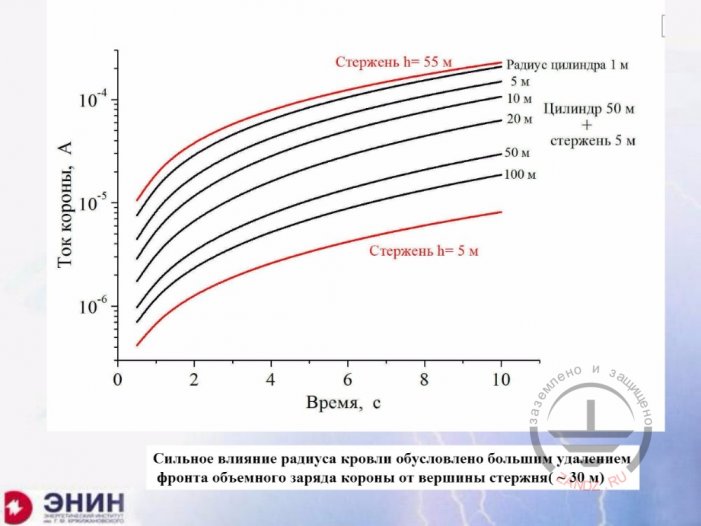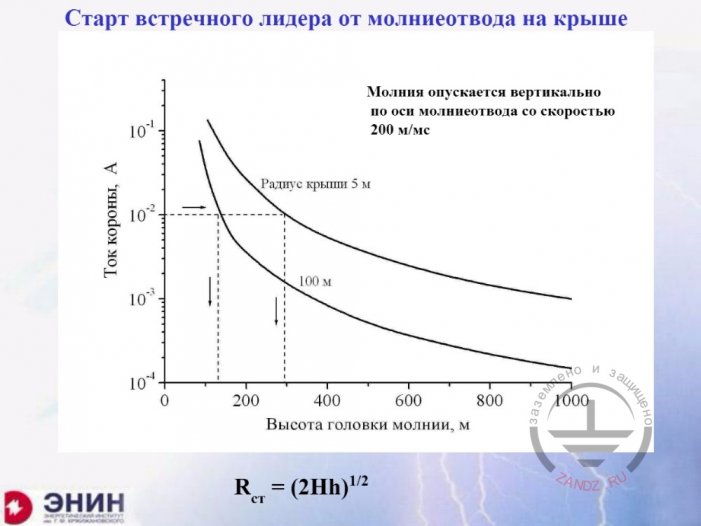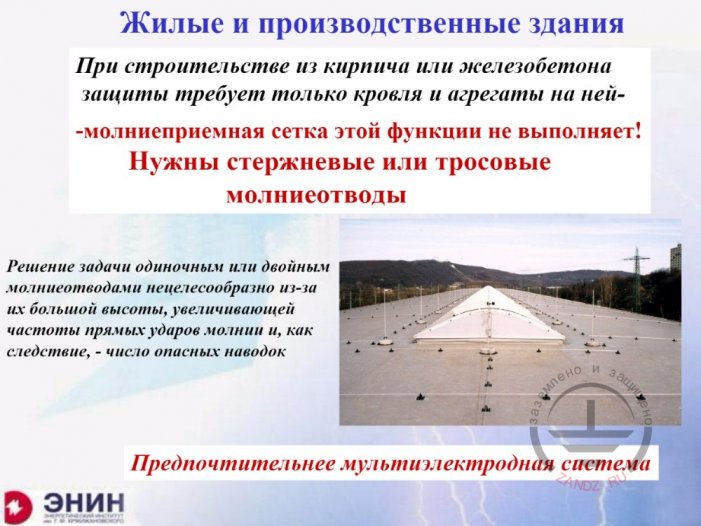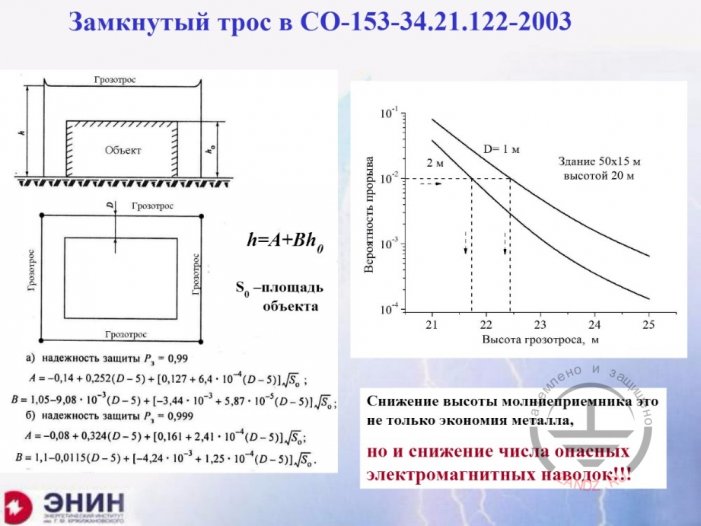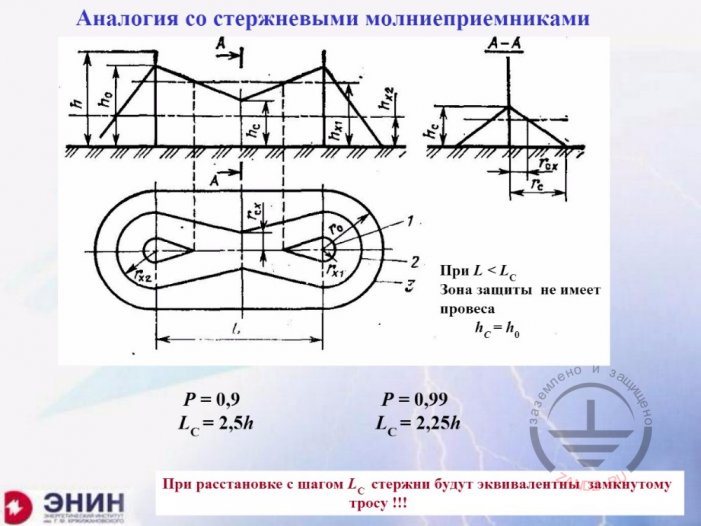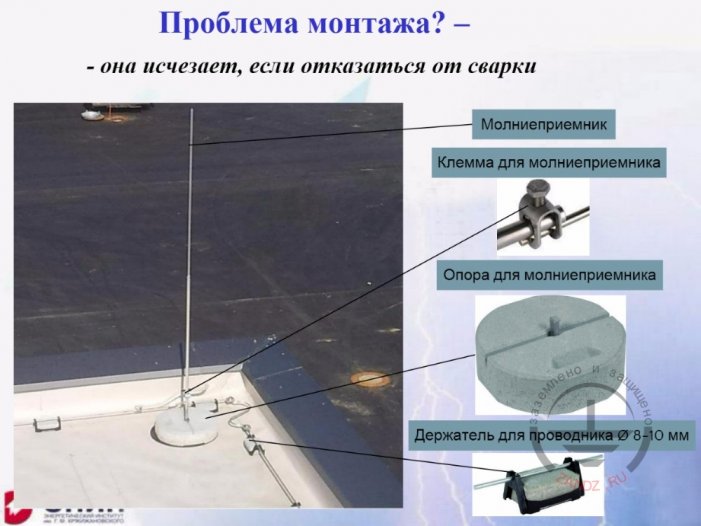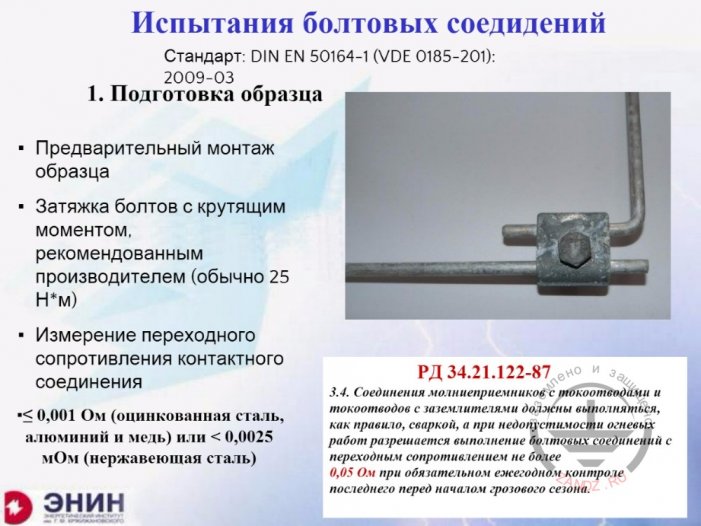The sixteenth webinar of the series "Grounding and lightning protection: questions and answers arising at the design"
Webinar text. Page 2
Quick navigation through slides:
1. For those who live on the roof
2. Useful production room
3. Regulatory requirements
4. Lightning protection of category III
5. Mesh on reinforced concrete slab
6. What do we need mesh over slabs for?
7. The difference between the standard IEC 62305 and IS 153-34.21.122-2003
8. Corona current change diagram
Corona current dependency diagram
Ток короны, А – Corona current, A
Стержень - Rod
Радиус цилиндра- Cylinder radius
Цилиндр - Cylinder
Стержень - Rod
Время, с – Time, s
Сильное влияние радиуса кровли обусловлено большим удалением фронта объемного заряда короны от вершины стержня (30 м)- Strong impact of roof radius is conditioned by large remoteness of corona spatial charge front from the top of the rod (30m)
— It's not only the prerogative of such high-rise buildings. I made approximately the same calculations for a simpler case; I took a building 50 meters high. I got dependencies which tell practically the same. The less is the roof radius, the weaker is the effect of the lightning rod protective action, and a roof with a large diameter shields the top of the lightning rod and it starts to function not that well. Neither Russian, nor foreign document takes this fact into consideration. It means that everything that is done in this relation is only a convention.
Counter leader start from a lightning rod on the roof
Ток короны, А – Corona current, A
Радиус крыши- roof radius
Высота головки молнии, м – height of lightning head, m
Молния опускается вертикально по оси молниеотвода со скоростью 200 м/мс – lightning descends vertically along the lightning rod axis with the speed of 20 m/ms
— The convention lies in another thing. Counter leader start which intercepts lightning is different on roofs of different radius. And the influence is significant, it is shown here. If we take roof radius of a 50-meters-high building equal to 5 meters, then the counter leader will arise, when lightning is at the height of 300 meters.
Residential and industrial buildings
At the construction of brick or reinforced concrete – only the roof and equipment on it should be protected
Lightning protection mesh doesn’t perform this function
Rod or catenary wire lightning rods are required
Solution of the task with single or double lightning rods is not reasonable due to their great height; increase the frequency of direct lightning strikes, and, consequently, number of dangerous pickups.
Multi-electrode system is more preferable
— I think I've already showed you one picture. I made it on the roof of one warehouses of a lightning protection company in Germany. Covered climate-control machines are located in the centre of this thing. And rod lightning rods stand around the zone which should be protected from a direct lightning strike. These rods are 2,5 meters high and are located around the whole perimeter of the protected area. They will provide protection according to IEC standards, but if you try to do the same, Gostekhnadzor will tell you that you have no minor ground to make the same protection. Do you know how to struggle with Gostekhnadzor and to make rational lightning protection? In my opinion, the answer is yes.
Ground wire in IS 153-34.21.122-2003
Грозотрос – ground wire
Объект - object
Площадь объекта – object square
Здание высотой 20 м – the building is 20 m high
Вероятность прорыва – breakthrough probability
Высота грозотроса, м – ground wire height, m
Надежность защиты – protection reliability
Снижение высота молниеприемника это не только экономия металла, но и снижение числа опасных электромагнитных наводок- reduction of lightning rod height is not only saving of metal, but reduction of the number of electromagnetic pickups.
— The regulatory document IS-153-34.21.122 offers a ground wire. This ground wire is arranged around the external perimeter of the protected object. You put 4 supports and plan a ground wire on them. This ground wire is very effective if it is put outside the protected area. Of course, you don't have to build it necessarily on supports standing on the ground; you can run it on the supports standing on the rood. But it would be great if the angle in relation to the protected area is negative.
Correspondence to rod lighting rods
При – at
Зона защиты не имеет провеса – Protection zone doesn’t have a sag
При расстановке с шагом L стержни будут эквивалентны замкнутому тросу – with the placement using the distance L, the rods will be equivalent to the closed wire
— I take a standard picture which can be found in all our lightning protection guidance. This standard picture shows me the protection zone of a double rod lightning rod. Here is one lightning rod, here is another, and this is the protection zone inside this rod lightning rod. This distance is a protection zone sag, it can be zero, and protection zone can be a vertical line in case if the distance between the lightning rods is 2,5 m high or less for a protection zone with a reliability of 0,9. Or if your distance between the rods is 2,22 of their height or less, if your protection zone reliability is 0,99. So in other words, if you put a 3-meter lightning rod on the roof and the distance between these lightning rods is 6 something meters or less; their protection zone turns into a straight horizontal line. Then this protection zone is equal to the wire protection zone and it means that you can substitute ground wires to lightning rods easily. If you put them with a distance which corresponds to these calculation formulas from any lightning protection guidance. So a ground wire can be substituted with a set of lightning rod and lightning protection won't suffer. But these distances should be observed. They are recorded in IS 153-34. You will find them for any protection reliability.
Installation problems
Она исчезает, если отказаться от сварки – it disappears if not to use welding
Молниеприемник – lightning rod
Клемма для молниеприемника – termination for the lightning rod
Опора для молниеприемника – support for the lightning rod
Держатель для проводника – holder for the lightning rod
— Imagine, you have to protect 30-40 meters area on a roof of a modern building. You will put lightning rods with the distance between them of 6 meters. How many rods will you need? You will need more than ten, fifteen, or even twenty rods, depending on the distance. How to install them? Because according to the Russian regulations all works with lightning rods should be performed by welding. Welding is not applied in Europe anymore. In Europe they put lightning rods like you see on this picture from some promotion posters. You see there is a metal post. It has a foundation, and you can put cement blocks on it to fix it on the roof.
Bolt connections test
Standard: DIN EN 50164-1
-
Preparation of a sample
Preliminary installation of the sample
Tightening of bolts with a torque recommended by the manufacturer (usually 25 H*m)
Measuring of the transient resistance of the contact connection
<= 0,001 Ohm (galvanized steel, aluminium and copper) or <0,0025 mOhm (stainless steel)
AD 34.21.122-87
3.4. Connections of lightning rods with down conductors and down conductors with ground electrodes should be performed by welding, as a rule. And if flame works are not allowed, bolt connections with a transient resistance not more than 0,05 Ohm can be performed with an annual control of the latter before the thunder season
— Why we can do it this way? Look at the bolt connections shown on this poster; they are tested in the following way. They are tightened with the force of 25 N*m, then the transient resistance together with the bolt clamp connection of lightning protection elements should be not higher, than 1 mOhm, if it is non-ferrous metal and 2,5 mOhm if it is stainless steel.
<< Previous Page
slides from 1 to 8
Next Page >>
slides from 16 to 22+ questions and answers session
Useful materials for designers:
- Webinars with the leading industry experts
- Everything for the calculation of grounding and lightning protection
- Useful materials: articles, recommendations, examples
Related Articles:
 6. How to do that?
6. How to do that?


